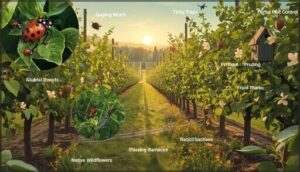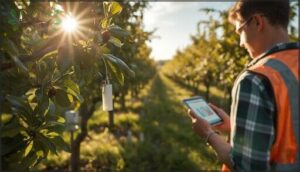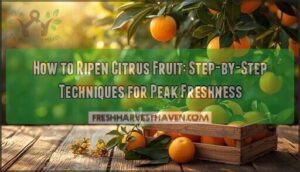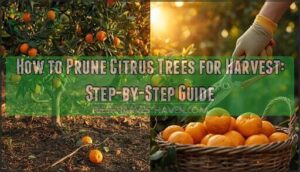This site is supported by our readers. We may earn a commission, at no cost to you, if you purchase through links.
You can lose 20% of your crop before you even notice the culprit. That’s the reality when codling moth, plum curculio, or brown marmorated stink bug establish themselves in your orchard—and by the time damaged fruit appears, populations have already exploded.
Traditional calendar-based spraying burns through your budget while pests adapt, beneficial insects disappear, and resistance builds with each passing season.
Effective orchard pest management strategies demand a smarter approach: one that reads your landscape like a diagnostic map, deploys controls precisely when thresholds justify action, and leverages biological allies instead of fighting nature. This shift from reactive spraying to integrated decision-making doesn’t just protect your harvest—it builds resilience into every acre you manage.
Table Of Contents
Key Takeaways
- Effective orchard pest management requires shifting from calendar-based spraying to integrated decision-making that combines habitat surveys, threshold monitoring, and precise intervention timing—reducing pesticide applications by 25-42% while maintaining crop protection.
- Layering cultural practices (sanitation, cover crops), biological controls (beneficial insects, mating disruption), and mechanical methods (exclusion netting, trunk banding) before resorting to selective chemical interventions creates resilient pest suppression that prevents resistance development.
- Real-time monitoring through pheromone traps, degree-day models, and IoT sensors enables you to predict pest emergence within 3-10 days and target vulnerable life stages, achieving up to 90% control accuracy when interventions align with pest cycles.
- Ground cover diversity and habitat enhancement boost beneficial insect populations by 114% while supporting natural enemies that deliver 40-52% pest suppression through parasitism and predation, building ecosystem resilience that compounds across seasons.
Assessing Orchard Pest Risks
Understanding the pest pressure in your orchard starts long before you ever reach for a spray bottle. You need to assess the full landscape—from the soil beneath your trees to the neighboring fields that might harbor unwanted guests.
Let’s walk through the essential risk factors you should evaluate before pests become a problem.
Surveying Orchard Habitats for Pests and Beneficials
Habitat assessment grounds your entire orchard ecosystem management plan. You can’t defend what you don’t understand—so map the terrain where pest dynamics and beneficial insects collide.
Three survey layers enable integrated pest management success:
- Canopy sampling using suction devices captures 1.5 times more taxa than beating trays, revealing hidden parasitoids critical for insect pest control
- Ground-cover surveys across bare soil, grass, and planted strips expose biodiversity conservation opportunities where beneficial-to-pest ratios shift
- Edge transects extending 100 m from flower margins detect natural-enemy recruitment zones that deliver ecosystem services into production rows
Weekly visual inspections during the growing season—combined with attractant traps synchronized to pest life cycles—transform raw data into actionable pest identification and control decisions. Stratify by microhabitat, because spiders dominate grassy patches while ants concentrate in sown cover, and each stratum plays a distinct role in pest monitoring techniques that protect your crop. Understanding natural enemy populations is essential for effective pest management strategies.
Monitoring Soil Health and Microclimates
Below the surface, your orchard ecosystem reveals how soil biological health shapes pest life cycles. Soil moisture management and microclimate monitoring together predict when soil-dwelling pupae will emerge—fungi controlling fruit-fly mortality peak at 20–30°C and specific water potentials.
Track microbial populations (Trichoderma, Streptomyces) for replant disease suppression, measure soil pH regularly, and deploy IoT sensors to capture temperature-humidity shifts that trigger outbreaks before threshold populations establish.
Understanding soil health management is vital for maintaining a balanced ecosystem.
Identifying Key Orchard Pests and Diseases
Once you’ve mapped your microclimate data, pinpoint the threats that actually matter. In U.S. apple orchards, brown marmorated stink bug, plum curculio, Oriental fruit moth, and San Jose scale dominate Integrated Pest Management priorities.
Pacific Northwest hazelnut growers face aphids on 100% of surveyed acreage—causing 2.4% yield reduction—while Eastern filbert blight drives another 6.1% disease loss per acre, demanding precise Pest Management protocols rooted in Orchard Ecology and Pest Life Cycles understanding.
Evaluating Influences From Neighboring Land
Your orchard doesn’t exist in isolation—Cross Boundary pest movement from neighboring land reshapes your Pest Management Strategies. Border Effects, Landscape Dynamics, and Ecological Interactions determine whether adjacent habitats supply beneficial predators or harbor pest reservoirs, directly influencing your Integrated Pest Management success and Agricultural Sustainability.
Mediterranean studies show flower margins can push phytophagous insect densities 2.5 times higher at borders, while apple blocks near unmanaged peaches experience late-season Oriental fruit moth spikes.
Scouting and Monitoring Techniques
Effective pest management starts with knowing what’s actually happening in your orchard, not just reacting when damage appears. You’ll need reliable methods to detect pests early, track their populations over time, and decide when intervention makes sense.
The following techniques give you the eyes and ears to stay ahead of problems before they spiral out of control.
Using Pheromone Traps for Insect Detection
You’ll gain precise control over orchard pests when you deploy sex pheromone traps strategically—these tent-shaped monitors detect codling moths, peach tree borers, and filbert worms with striking accuracy.
For ideal insect monitoring:
- Hang traps in late spring at one per 2.5 to 10 acres
- Position them at pest-entry hotspots for targeted detection
- Check weekly to track population thresholds
- Replace lures as effectiveness declines seasonally
- Integrate trap data with degree-day models
Proper trap placement and lure efficiency directly influence your integrated pest management success.
Visual Inspections and Crop Scouting Methods
Weekly visual inspections form the backbone of effective pest surveillance in orchards. You’ll detect over 70% of outbreaks early when you scout every 7 to 10 days during the growing season.
Digital scouting platforms and GPS mapping improve your crop monitoring precision by 30%, enabling targeted IPM techniques.
Combining these pest scouting methods with visual analysis reduces unnecessary pesticide applications by up to 30%, strengthening crop protection while maintaining ecological balance.
Recording and Interpreting Pest Data
Precision in record keeping transforms raw observations into actionable pest management strategies. Document every scouting event with standardized pest data—date, location, and population density—to build a foundation for data analysis that drives IPM techniques forward.
Your digital monitoring system should capture:
- Trap counts and infestation levels across orchard blocks
- Environmental conditions correlating with pest tracking patterns
- Historical trends enabling accuracy metrics refinement
Automated insect monitoring platforms reduce manual errors by over 30%, delivering real-time pest data that sharpens your control decisions.
Setting Thresholds for Action
You can’t manage what you don’t measure—that’s where action levels become your decisive edge. Threshold values define when pest density warrants intervention, balancing economic injury against control costs.
Through systematic scouting and pest monitoring, you’ll apply threshold models that sharpen decision making in IPM techniques. Setting these benchmarks transforms data into targeted pest management, preventing losses without unnecessary applications.
Implementing Integrated Pest Management
Once you’ve identified the pests threatening your orchard, it’s time to act with a strategic combination of controls that work together rather than relying on any single approach. Integrated Pest Management isn’t about reaching for the spray bottle first—it’s about layering cultural, biological, mechanical, and chemical tactics in a way that protects your trees while preserving the ecosystem around them.
Integrated Pest Management layers cultural, biological, mechanical, and chemical tactics to protect trees while preserving the ecosystem around them
Here’s how you can build a practical IPM program that keeps pest pressure manageable and your orchard thriving.
Cultural Practices for Pest Prevention
You can slash pest populations before they explode by mastering cultural practices—the backbone of sustainable orchard management. Sanitation methods like removing fallen fruit cut infestations by up to 35%, while strategic tree pruning improves spray penetration and reduces disease by 15–25%.
Crop rotation disrupts pest life cycles, and cover crops boost beneficial insects by 114%. These orchard hygiene fundamentals strengthen your integrated pest management program without relying solely on chemicals.
Biological Controls and Beneficial Insects
Natural enemies become your frontline defense when you support beneficial wasps, predatory mites, and native lady beetles. 76% of pear growers already rely on biological pest control methods.
Parasitism rates exceed 40% in habitat-enhanced plots, while bird predation slashed codling moth larvae by 52% in monitored orchards. These natural enemies drive pest suppression without chemical dependency, strengthening your integrated pest management framework.
Mechanical and Physical Control Methods
You can physically block pests before they reach fruit. Trunk banding intercepts codling moth larvae as they migrate to pupation sites, while fruit bagging slashed damage from 34% to 10% in Montana trials.
Exclusion netting cut apple maggot captures by 96%, and reflective mulches repel aphid vectors on contact.
Flame weeding at the 2–4 leaf stage delivers 90% dicot control, targeting weeds that harbor secondary pests.
Responsible Use of Chemical Controls
When mechanical and exclusion tactics fall short, chemical control becomes your fallback—but only when scouting confirms economic thresholds. Pesticide use demands precision: rotate insecticide classes to sidestep resistance management pitfalls, time applications to pest life cycles, and choose reduced-risk formulations that lower environmental impact by nearly 90%. You’ll protect beneficial insects, meet pesticide regulation standards, and preserve long-term integrated pest management effectiveness.
- Rotate chemical classes to delay resistance in target populations
- Document every application for traceability and compliance audits
- Apply only at action thresholds to minimize toxicity levels and runoff
Combining Multiple Strategies for Effectiveness
Chemical interventions work best when they’re not working alone. When you layer cultural practices, biological control, and mechanical methods with selective insecticides, you’ll see a 65% drop in codling moth populations and cut pesticide applications by 42%.
This pest synergy approach strengthens resistance management, delivers economic benefits through lower costs per hectare, and boosts ecosystem health—your orchard IPM becomes adaptive, resilient, and genuinely sustainable.
Timing and Application of Pest Controls
You can have the most advanced IPM toolkit in the world, but if you don’t time your interventions correctly, you’re basically fighting with one hand tied behind your back. Pest control isn’t just about what you apply—it’s about when you apply it, matching your actions to the vulnerable stages of pest development and the critical windows in your trees’ growth cycle.
The following strategies will help you synchronize your control measures with the rhythms of orchard ecology, turning timing from guesswork into a competitive advantage.
Scheduling Dormant and Seasonal Sprays
Effective spray timing hinges on pest forecasting and a deep understanding of pest life cycles. Dormant spray applications in late winter target overwintering insects before bud swell, achieving up to 65% mortality on mites and other pests.
Seasonal sprays aligned with pest vulnerability—rather than rigid calendars—reduce insecticide use by 25-30% while maintaining crop protection. This spray optimization approach strengthens your orchard IPM strategy without sacrificing control.
Using Bud Stage Charts for Accurate Timing
Bud stage tracking transforms timing of sprays from guesswork into precision agriculture. Using bud stage charts, you’ll synchronize dormant spray applications and spring spray schedules with measurable phenological events—silver tip to petal fall—for ideal pest suppression.
Phenology mapping combined with degree day calculations facilitates accurate pest cycle modeling, while frost risk assessment protects vulnerable buds.
This evidence-based approach achieves up to 70% control accuracy when interventions match bud stages precisely.
Rotating Insecticides to Prevent Resistance
Three distinct insecticide rotations per season represent your primary defense against resistance management failures. You’ll need products from different IRAC mode-of-action groups—never back-to-back applications of identical mechanisms.
This pest control strategy restored susceptibility in resistant populations within two growing seasons while reducing applications by 20% annually.
Rotation integrated with chemical alternatives and sustainable practices delays resistance gene selection by at least two years, protecting your integrated pest management investment.
Adapting Controls to Pest Life Cycles
Precision in timing controls transforms your pest management from guesswork to calculated intervention. Degree day models let you predict codling moth emergence within three days, synchronizing sprays with vulnerable larval stages—reducing unnecessary applications by 30% annually.
Target second-generation flights when they’re most damaging; early releases of predatory mites suppress spider mite outbreaks within one week, cutting leaf damage by 90%.
Advancing Orchard Pest Management
Modern orchard management is shifting toward smarter, more sustainable practices that reduce your reliance on conventional insecticides while protecting crop yields.
You can achieve this balance by integrating advanced detection tools, ecological strategies, and adaptive monitoring systems into your IPM program.
The following approaches will help you stay ahead of pest pressures and maintain a resilient, productive orchard ecosystem.
Incorporating Real-Time Pest Detection Technologies
Real-time pest detection technologies transform how you monitor orchard threats. Deep learning models and AI pest detection systems can identify insects with over 92% accuracy in milliseconds, while IoT sensors continuously track environmental conditions that predict pest pressure.
UAV monitoring surveys large blocks quickly, and predictive modeling links weather data to infestation risk. These tools improve integrated pest management by enabling precise, timely interventions that complement traditional methods like pheromone traps.
Supporting Biodiversity With Ground Cover
Ground cover acts as the foundation of sustainable orchard management, strengthening your soil ecosystem while delivering vital ecosystem services. You’ll boost biodiversity enhancement by planting diverse cover crops that support pollinator populations.
Orchards with ground cover harbor 45 spiders and 109 parasitoids per plot compared to bare soil’s meager 32 spiders and zero parasitoids. This agroecology approach improves soil health, advances soil conservation, and elevates beneficial insect activity by 15–20%.
Mating Disruption and Pheromone Techniques
Mating disruption saturates your orchard with synthetic sex pheromones, confusing male moths so they can’t locate females—a cornerstone of integrated pest management that’s revolutionizing biological controls. Over 90% of U.S. apple and pear orchards now deploy this strategy, slashing insecticide use by 44–45% while delaying pest resistance.
- Pheromone traps in disrupted blocks show 89.5% suppression of target moths
- Larval fruit damage drops up to 71% in well-managed sites
- Pheromone trap monitoring confirms male catch reductions exceeding 90%
- Pheromone efficacy peaks in blocks larger than 10 acres with area-wide coverage
Continuous Evaluation and Record Keeping
Successful integrated pest management hinges on rigorous pest data analysis and record keeping. Your scouting logs, spray timings, and pest counts form the blueprint for adaptive orchard management. In fact, 87% of commercial operations update records weekly during peak season, and orchards with thorough documentation see a 14% boost in marketable yield.
Track block-specific infestation levels, product EPA numbers, and weather conditions to satisfy compliance reporting and orchard audits while refining pest control strategies.
| Record Element | Impact on Sustainability Metrics |
|---|---|
| Pest severity ratings (0–5 scale) | Facilitates targeted interventions, cutting pesticide use by 19% |
| Block-level spray logs | Reduces resistance development by 17% |
| Real-time IoT sensor data | Anticipates outbreaks 10 days ahead, boosting cost efficiency 15% |
Digital platforms slash labor costs by 17% and guarantee you’re audit-ready—92% of regulated managers now store pest management records in secure cloud systems.
Updating Strategies With New Research
Emerging research reshapes Integrated Pest Management practices faster than ever—AI-driven pest forecasting, cutting-edge biological control agents, and data analysis platforms are game-changers you can’t ignore. Stay ahead by:
- Subscribing to university extension bulletins for adaptive management insights on enhanced pest control strategies and tech integration.
- Piloting novel IPM practices in test blocks before orchard-wide rollout.
- Networking with regional growers to share research updates and improve pest management strategies collaboratively.
Frequently Asked Questions (FAQs)
What are economic thresholds for minor orchard pests?
You’ll act when pest density hits 10–20% of terminals for aphids or 30–50% infested leaves for mites—threshold values designed so your IPM practices prevent minor pest damage before economic injury outweighs control costs.
How does climate change affect pest population cycles?
Climate change accelerates pest development through warmer temperatures, enabling additional generations per season and earlier spring emergence.
You’ll face extended damage windows, increased overwintering survival, and greater resistance evolution as pest population cycles intensify under shifting thermal conditions.
What are best practices for post-harvest pest control?
Post-harvest pest control isn’t just about spraying—it’s about sanitation methods, storage management, and fungicide use.
You’ll need rigorous bin cleaning, prompt cooling, and fungicide rotation to prevent pest resistance while maintaining effective postharvest monitoring throughout fall orchard maintenance.
How can growers manage invasive pest species effectively?
You’ll need to understand pest ecology and lifecycle patterns, then layer integrated pest management techniques—biological methods, cultural controls, and targeted chemical interventions—to disrupt invasive species before they establish damaging populations.
What financial incentives exist for adopting IPM practices?
You’ll find Federal Grants and Cost Share Programs like EQIP covering up to 75% of IPM costs, while State Incentives, Certification Premiums, and Industry Funding support Sustainable Agriculture through Integrated Pest Management adoption.
Conclusion
Like a chess player anticipating moves three turns ahead, successful orchard pest management strategies position you to intercept threats before they cascade into crop loss. You’ve gained the diagnostic framework, monitoring precision, and integrated toolkit to shift from crisis response to proactive stewardship.
Each scouting pass, each threshold decision, each biological ally you protect compounds your advantage—building orchards that don’t just survive pest pressure, but thrive through it season after season.
- https://www.scribd.com/document/942127975/Integrated-Pest-Management-Success-Stories-and-Key-Takeaways
- https://extension.oregonstate.edu/news/integrated-pest-management-makes-backyard-orchards-easier
- https://www.sciencedirect.com/science/article/abs/pii/S0167880919303391
- https://geneticliteracyproject.org/2018/05/23/a-behind-the-scenes-look-at-pesticide-use-in-organic-orchards-vineyards-and-fresh-produce/
- https://pmc.ncbi.nlm.nih.gov/articles/PMC8709102/











